Agriculture is an important economic sector in Humboldt County, Nevada. There are over 350 farms and ranches in the county that operate on over 808,000 acres. Sales from agricultural products totaled just over $135 million in 2012 (last census of agriculture). Of this, $102 million was from crop products and almost $33 million was from livestock products. Humboldt County accounted for 17.7 percent of all agricultural product sales in Nevada, which ranks the county first in agricultural production. Alfalfa hay is the primary irrigated crop, but other crops include mint, alfalfa seed, small grains, potatoes and peas. Dairies located out of state buy the majority of the alfalfa crop. Irrigation for most crops comes from groundwater from deep wells. For native (i.e., wild) grass hay meadows, seasonal irrigation occurs in the spring with surface water drawn from streams, provided winter precipitation is sufficient for runoff to occur. Grass hay meadows are an important part of the county’s livestock production, meeting critical winter forage supplies. Beef cattle are the primary livestock, with cow-calf operations being the primary production program. The Jan. 1 census typically reports 58,000 to 65,000 cattle and calves on the ranch. The economic multipliers for both crop and livestock production are large, with each new on-farm position resulting in up to three additional jobs in the county. Agricultural water use from irrigation varies by crop and soil type, but the overall estimate is about 384,000 acre-feet per year. If water is withdrawn from irrigation, the likely result will be large areas of abandoned cropland, most of which will revert to weeds. These weeds could easily expand to adjacent private and public lands creating a suite of adverse management issues.
Humboldt County is an agricultural leader in Nevada, for both the size and breadth of its agricultural production (U.S. Department of Agriculture 2014). The crop and livestock sectors are both large. The 2012 Census of Agriculture (USDA 2014b) identified 359 farms and ranches that owned 808,872 acres (Table 1). Not all of the land on farms and ranches is managed cropland or used to produce marketable products. All agricultural operations have land dedicated to storing crops and equipment, providing housing, containing access roads, and hosting utility lines and other essential infrastructure needed for the farming/ranching operation. Some farms also have large areas that are not suitable for growing crops and remain undeveloped. Many ranches have hundreds to thousands of acres of rangeland that produce potential forage, but are ungrazed when the locations are too far from water or reside on terrain too steep or rough for livestock to access.
The average size of a farm or ranch in Humboldt County is about 2,253 acres, with about one-half being at least 200 acres (Tables 1 and 2). More than 120 operations covered 500 or more acres, and 69 covered 1,000 or more acres (Table 2). Seventy-one operations owned nine or fewer acres; thus, small farms, tended by “part-time” farmers are common in Humboldt County.
Agriculture’s direct economic contribution from the sale of crops and livestock in in Humboldt County, in 2012, was $135.3 million (Table 1). This ranks Humboldt County first for agricultural production among Nevada’s 17 counties, and accounted for 17.7 percent of all crop and livestock sales in the state ($764.1 million). At the scale of the United States, Humboldt County’s $135 million of agricultural sales ranked it among the top 29 percent of all U.S. counties.
Table 1. Summary of agriculture in Humboldt County, Nevada in 2012. Data from USDA 2014b.
1Primarily alfalfa hay; native (wild) grass-hay; tame hays (e.g., Timothy); alfalfa seed; mint; peas; potatoes; winter and spring small grains for seed, grain or hay; and other minor crops occur.
*need table here
Table 2. Number of farms/ranches in Humboldt County, Nevada, and total acres on those properties in 2012 and 2007, number of farms with irrigated acres, and number of acres irrigated in 2012 and 2007. Data are stratified by farm size and are from USDA 2014b.
1D Value not shown to prevent identification of individual properties.
*need table here
Table 3. Total number of farms and ranches in Humboldt County, Nevada, with irrigated land, harvested cropland, other cropland (excluding pasture), and pastureland in 2012 and 2007 (USDA 2014b). Data for each attribute also include the total acres and irrigated acres in in 2012 and 2007.
*need table here
Table 4. Total number of farms, acres harvested and acres irrigated by crop in 2012 and 2007 in Humboldt County, Nevada. Data from USDA 2014b and USDA 2016.
1Alfalfa seed harvest = 2.25 million pounds in 2012 and 3.024 million pounds in 2007
2Values not shown in agricultural statistics to prevent identification of individual properties and/or landowners.
3Grass hay found in seasonally irrigated meadows, often in or adjacent to flood plains. Common native species includes creeping wildrye (Leymus triticoides), basin wildrye (Leymus cinereus), and alkali sacaton (Sporobolus airoides). Introduced species common on grass-hay meadows include timothy (Phleum pratense) and garrison creeping foxtail (Alopecurus arundinaceus).
*need table here
Crop Production
Of Humboldt County’s total income from agricultural sales, approximately $102.4 million was from the sale of crop products, and $32.9 million was from livestock and livestock products (Table 1). The gross receipt per ranch or farm averaged $377,000 (Table 1), with 136 operations reporting sales of $100,000 or more. There were 139 small operations reporting sales of $2,500 or less. The market value of land and buildings averaged $2.2 million per farm or ranch, equating to about $991 per acre (Table 1). The value of machinery and equipment averaged $271,000 per farm or ranch.
Alfalfa hay production near Orovada, Nevada.
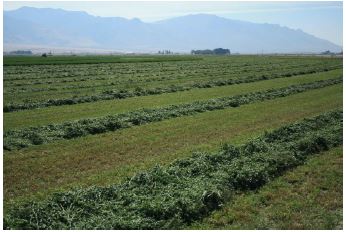
In 2012, Humboldt County reported 165,292 acres of total cropland, of which 137,470 acres were irrigated (Tables 1 and 3). About 74 percent of all irrigated acres were hay, with alfalfa hay being about 75 percent of all hay production (Table 4). From 2012 through 2015, tens of thousands of acres of native grass hay meadows along the Humboldt River and other small streams, which are important to livestock production, went without irrigation due to prolonged drought and low streamflow. Irrigation on these sites finally resumed in the spring of 2016.
The 2014 crop survey (USDA 2016) reported alfalfa hay production on 67,000 acres and a harvest of 337,000 tons, for just over 5 tons per acre. Much of the alfalfa crop is dairy-quality alfalfa that can sell for well over $200 a ton in good years, but can fall to well under $200 a ton in fair or poor market years. Farmers largely export dairy-quality hay to California or Idaho, the first-and fourth-largest milk-producing states.
Alfalfa seed crop with sheds for bees used to pollinate the crop.

In 2014, the average price of alfalfa hay was $241 per ton; thus, alfalfa production that year generated about $81.2 million of gross income for Humboldt County. Based upon the 2012 Census of Agriculture, the value of hay sold from Humboldt County was the 32nd largest in the United States (by county), ranking Humboldt County in the top 1 percent of hay- producing counties in the United States.
Alfalfa farmers often grow wheat and other small grains as a rotation crop, every five to seven years. Farmers will often harvest the small grain crop early as hay, which allows for a quick plant back to alfalfa later that growing season. In 2012, the harvest of wheat for grain occurred on over 11,000 acres in Humboldt County (Table 4).
Other important field crops in Humboldt County include alfalfa seed and mint. In the recent past, seed crops have also included wheat and other small grains and grass seed. The alfalfa seed and mint crops are high-value commodities that require specialized equipment for harvest and/or processing. Potatoes, until recently, were a high acreage crop (6,000 to 8,000 acres per year). In recent years, acres planted with potatoes have declined and been replaced by peas for snack foods.
Mint crop near Orovada, Nevada, nearing harvest. The design of this center-pivot irrigation system places water directly on the soil surface, largely to enhance the quality of the mint oil.
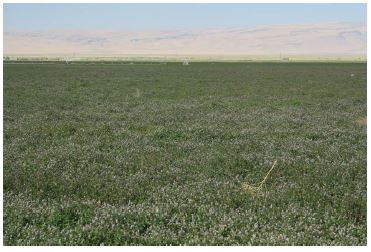
Livestock Production
Livestock production in Humboldt County is primarily beef cattle and their calves (Table 5). The county is home to only one large sheep operation. Almost all cattle ranches are in the cow-calf business, with calves being the primary product sold. Most of the calves leave the state in the fall and early winter, following weaning. Few calves are kept on the ranch and fed harvested forages all winter due to the high cost of providing adequate high quality feed to meet the calves’ nutrient and energy demands for both maintenance (staying alive) and growth (adding bone and muscle) during the cold winter months.
Table 5. Total number of ranches/farms and livestock in Humboldt County, Nevada, recorded during annual census for 2012 and 2007. Data from USDA 2014b.
1Values not shown in agricultural statistics to prevent identification of individual properties and/or landowners.
2Vast majority of sheep come from one producer.
*need table here
One primary destination for calves from Humboldt County is the annual grass rangelands of northern and central California. Calves weaned in the fall leave behind dry and dormant forages (i.e., low-quality feed) and arrive on California’s rangelands about the time the fall/winter rains begin. The rapidly greening annual grasses provide a nutritious forage, which is much better suited for continued growth than are the dry, harvested forages in Humboldt County. Warmer winter temperatures in California also result in greater weight grains. In essence, livestock production in Humboldt County is part of a regional production system that provides nutritious green forage throughout much of the first 12 months of each calf’s life: the period when muscle and bone development are greatest. In the fall, ranchers also sell their low-value bulls, as well as cows (cull cows) that typically failed to produce a calf the past spring.
Flood-irrigated grass hay meadow in Paradise Valley, Nevada, used to grow hay for winter feed. Water for these production fields is from creeks with abundant spring runoff.
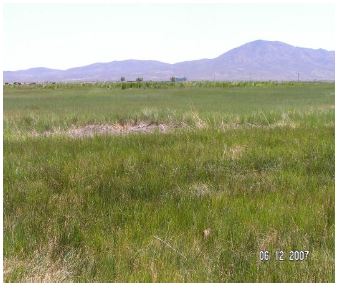
An important component of all ranching operations is the production of hay in the spring and summer. Hay or similar harvested forages (e.g., straw, silage) provide much of the cattle feed from late fall through late winter for the base herd of mother cows, unsold calves, bulls and ranch horses.
Beef cattle do not require the high-protein, highly digestible diet required by lactating dairy cows. Hay production, therefore, often focuses on lower quality, low-input native (wild) grass-hay forages; not high-quality, high-input alfalfa hay. Grass hay contains less nitrogen than does alfalfa hay; hence, provides much less protein per pound of feed, while still meeting most of the nutrient needs of pregnant cows and bulls. Supplemental protein, often from a small amount of alfalfa as part of the daily ration, typically meets any protein deficiency from a grass hay diet. Grass hay is the primary diet for beef cattle because production costs per ton are much less than for alfalfa, which helps lower winter feed costs; hence, overall production costs. This occurs, in part, because grass hay production mostly occurs in flood-irrigated meadows, using seasonally available water from creeks and rivers during the spring runoff period. Alfalfa hay production largely uses groundwater pumped from deep wells and distributed through expensive center-pivot or other pipe-based systems.
The use of surface water for grass hay production results in Humboldt County’s livestock sector being much more susceptible to drought than most farming operations. Humboldt County farms rely almost exclusively on groundwater for crop production; thus, their water supply fluctuates very little across years, especially compared to surface water sources.
The 2012 census of Agriculture identified 133 ranches that produced beef cattle, with 58,490 cattle and calves on the ranch at the time of the January census (Table 5). This was about 3,500 fewer than counted during the 2007 census, and 2,500 fewer than the 2015 survey of producers. Among surveyed Humboldt County ranches, 37 reported 500 or more cattle and calves on the ranch, with an average of 1,359 head per operation. Another 18 ranches reported 200 to 499 head in their inventory, for an average of 332 head per ranch. These 55 ranches housed about 96.2 percent of all cattle in Humboldt County. At the National level, in 2012, Humboldt County ranked in the top 16 percent of all counties for the value of cattle and calves sold ($32.4 million).
Typical spring (left photo) and summer (right photo) rangeland used for livestock production in Humboldt County, Nevada. Federal land management agencies administer most rangelands in the County.
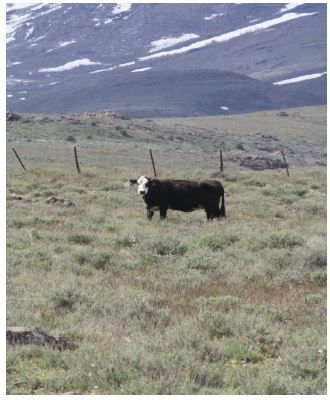
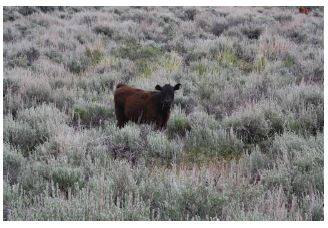
Access to federally administered rangeland is a critical component of large-scale livestock production in Humboldt County and much of the Intermountain West. Few ranches own enough land to maintain an economically viable unit without access to the federally administered rangelands. Cattle production involves somewhat complex private-public relationships between the ranch owner (and their help) and the two federal land management agencies that administer over 80 percent of the land in Humboldt County. For the lands they administer, the Bureau of Land Management and the U.S. Forest Service allow grazing under a permit system. Ranchers, often called permittees, have access to their grazing allotments for specific timeframes each year. Only one ranch may use an allotment, or several who run in common with one another. The grazing permit typically has a 10-year duration and is renewable provided the livestock producer has met the terms and conditions of the permit.
All economic sectors, including agriculture, have economic multipliers for final demand, employment and household income. That is, a one dollar increase (or decrease) in sales for a particular sector increases other economic activity by some value. Research conducted by the Center for Economic Development at the University of Nevada, Reno found that a $1 increase in livestock sales and alfalfa hay sales result in $2.32 and $2.08, respectively, of additional economic activity in Humboldt County. Of the 22 economic sectors studied, the final demand multipliers for livestock and alfalfa production were the second and third largest, after local government. Each new position added to the livestock and alfalfa hay sectors results in approximately 2.9 and 3.0 additional jobs in Humboldt County. The only nonagricultural sectors with larger employment multipliers were mining (3.0 to 3.2 additional jobs for each mining job) and construction (3.1 additional jobs). Economic multipliers also may work in reverse. A loss of dollars due to price declines, fewer sales, or a decline in jobs due to an economic contraction in a specific sector may result in less economic demand and fewer jobs across the community. This strong, diverse agricultural sector is important to the overall economy of Humboldt County.
Agricultural Water Use
The primary uses of agricultural water in Humboldt County are irrigation of crops and drinking water for cattle and calves. In 2012, the National Agricultural Census reported 137,470 irrigated acres in Humboldt County. Hay crops occupy most of the irrigated acres, with alfalfa hay occurring on over 75 percent of all acres producing hay (Table 4). Alfalfa hay typically uses more water than grass hay, whether it is tame hay (e.g., Timothy) or native (wild) grass hay meadows. Across all crop production in Humboldt County, the 2013 Farm and Ranch Irrigation Survey (USDA 2014a) reported that the average amount of water applied was 2.8 acre-feet, per irrigated acre. Multiplying 137,470 irrigated acres (in 2012) by 2.8 acre-feet per acre, suggests that crop irrigation uses about 384,916 acre-feet of water per year.
Crops consume the majority of the applied irrigation water during crop growth, but an unknown percentage (probably small, especially for sprinkler systems) may percolate past the root zone and enter shallow or deep aquifers. Most of the native (wild) grass hay meadows are flood irrigated with water from a river or small stream. These fields typically reside in or adjacent to the floodplain of the source stream. Flood irrigation almost always delivers more water than is consumed by the crop; therefore, some of the irrigation water moves past the root zone and eventually returns to the stream or passes to the groundwater via sub-surface drainage.
Almost all water consumed by livestock is from cattle and calves. All other livestock in combination represent a very small number compared to the number of cattle and calves (Table 5). The best estimate for potential livestock numbers is the Jan. 1 annual census. The 2012 agricultural census identified 58,490 head of cattle and calves on the ranch on Jan. 1 (USDA 2014b). This value includes bulls; cows without calves; calves recently sold but not shipped, and calves held over for another grazing season (i.e., yearlings) before their sale. The actual number throughout the year will vary around this value. Average water consumption by a mature cow, across an entire year is about 15 gallons per day (Heady and Child 1994; Rouda et al. 1994). Multiplying the Jan. 1 census of cattle and calves (58,490) by 15 gallons per head, by 365 days suggests that cattle consumption is about 320 million gallons or about 983 acre-feet (325,851 gallons per acre-foot of water). In recent years, cattle numbers have been as high as 65,000 on Jan. 1. A cattle population of this size would consume about 1,092 acre-feet of water.
Water consumption by all other livestock combined (about 4,000 head: Table 5) ranges from well under 1 gallon per day per head (poultry) to about 12 gallons per day (horses). This suggests a collective water consumption of under 25 acre-feet of water per year (for these 4,000 head). The combined direct consumption of water by all livestock in Humboldt County typically ranges from about 1,000 acre-feet per year when cattle numbers are low to 1,117 acre-feet per year when cattle numbers are high.
Issues With Removing Water From Irrigated Cropland
Around the globe, the permanent removal of water from arid cropland results in weeds and other unwanted vegetation establishing on the site (Bonet and Pausas 2004; Standish et al. 2006; Standish et al. 2007). The native vegetation does not re-establish on abandoned cropland in arid environments. This pattern of plant succession is likely in Humboldt County, where most cropland receives an average of 7 to 9 inches of precipitation per year. For the first year or two, perhaps longer if drought conditions occur, bare ground is very common. Windy conditions, a common phenomenon in Humboldt County, could easily cause large, widespread fugitive dust emissions from dewatered farmland that has little or no vegetative cover (Grantz et al. 1998).
A wide variety of weeds may initially occupy abandoned farmland, and most can become well established within the first two growing seasons after irrigation ends. These weeds may be invasive annual grasses and forbs such as cheatgrass, Russian thistle, and winter annual mustards or state-listed noxious weeds, such as Russian knapweed. All can competitively exclude desired perennial plants if their populations become large. Russian knapweed and many of the other noxious species (e.g., hoary cress, perennial pepperweed, and field bindweed) that are common on abandoned or degraded cropland are deep-rooted perennial herbaceous species. Their root systems may reach hundreds of linear feet (per plant), with each root having buds located every inch or so on the root. Each of these buds is capable of sprouting and producing a new plant. Most weeds that inhabit abandoned cropland are very difficult and costly to control once they become well established. It may take several, and often many consecutive years of treatment, to achieve large population declines and facilitate the establishment of desired vegetation.
Cropland abandoned in Humboldt County, Nevada, about 10 years ago. No native vegetation has established, and the vegetation is largely cheatgrass, Russian thistle, annual mustards and Russian knapweed.
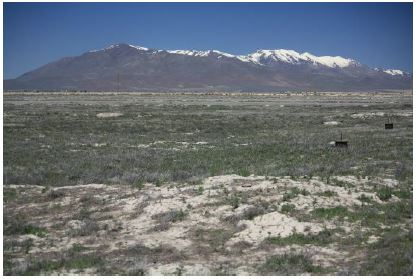
Once weeds occupy abandoned cropland, the area inhabited becomes a seed source and facilitates the rapid spread of weeds to both near and distant locations. Adjacent pasture and cropland is at immediate risk of greater weed pressures, often resulting in increased weed control, hence, production costs.
Seeds may spread rapidly by many mechanisms. These include attachment to the fur of animals; attachment of seed-infested mud to vehicles (ATVs, trucks, motorcycles, etc.), equipment or people (shoes, clothing), and its subsequent movement to another site; or seed consumed by birds and excreted at distant locations. In addition, seed may disperse long distances from strong winds, the movement of seed infested soil (often during construction) to new locations, and during periodic overland floods that occur after heavy rain or rapid snowmelt on saturated soil. The latter events also can erode the soil and break the roots of many sprouting perennial weeds into small segments that can easily be moved long distances during flood events.
Russian knapweed (tall gray-green plant), a dee rooted noxious weed, has become established in a stand of cheatgrass on abandoned cropland withdrawn from irrigation about 10 years ago.
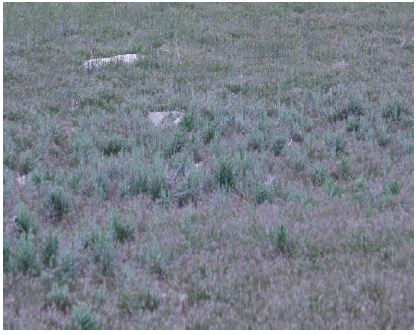
Weeds dispersing from abandoned cropland are a constant threat to establish on Humboldt County’s public lands. The extensive federal highway system (i.e., Interstate 80), in combination with state, county, private and two-track roads, connect literally every acre of cropland to millions of acres of public lands that support wildlife, livestock grazing, recreation and other resources that provide economic benefit to county residents.
Abandoned cropland also provides excellent habitat for ground squirrels and other vertebrate pests (e.g., gophers, voles, etc.). Pest control is rarely, if ever, applied to areas after the withdrawal of irrigation water, largely because there is no longer an economic incentive to control the pest species. These areas, however, provide a refugia where populations may expand rapidly when excellent breeding conditions occur. Large populations of herbivorous rodents can feed on the adjacent cropland and dramatically reduce crop production. A complete crop failure is possible if rodent populations become too large.
Ground squirrel amongst the cheatgrass and Russian thistle growing on abandoned agricultural land. Ground squirrels on degraded and/or abandoned sites often feed in nearby alfalfa stands.
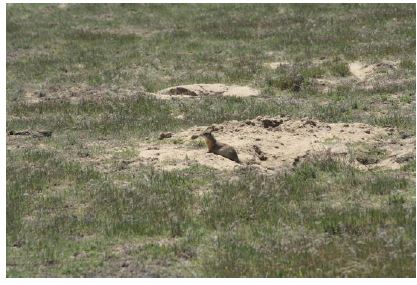
Summary
Agriculture in Humboldt County is diverse, and irrigation supports crop production on well over 100,000 acres. In good price years, agriculture can result in over $100 million of income in the county. Agriculturalists in Humboldt County export many of the agricultural commodities produced in Humboldt out of state; thus, they bring significant dollars into the county (Harris et al. 2014). Past research has found that the production of many crops and commodities have economic multipliers of $2 to $3 for each dollar of agricultural income (Harris et al. 1993).
The production of crop and animal commodities in Humboldt County must occur in a highly variable climate that includes long and cold winters, a short frost-free growing season, cool summer nights and hot summer days (i.e., large daily temperature ranges), low humidity, high winds, and intense ultra-violet radiation. Agriculture uses a substantial amount of groundwater, but also surface water in years when it is readily available. Water use for crop production is orders of magnitude greater than for watering livestock. The permanent removal of water from cropland typically results in abandonment of those lands, which can result in substantial adverse effects from fugitive dust, weeds and vertebrate pests both near and distant from the areas affected.
Data Sources
- USDAa. 2014. 2012 Census of Agriculture. Farm and Ranch Irrigation Survey (2013). Volume 3. Special Studies. Part 1. AC-12-SS-1. 266 pages. Available at: Census of Agriculture. Accessed on May 10, 2016.
- USDAb. 2014. 2012 Census of Agriculture. Nevada State and County Data. Volume 1, Geographic Area Series. Part 28. AC-12-A-28. Available at: 2012 Census Volume 1, Chapter 2: County Level. Accessed on May 10, 2016.
- USDA. 2016. National Agricultural Statistics. Quick Stata Database. Alfalfa Acres Harvested, Humboldt County, Nevada. Available at: Quick Stata Database. Accessed on May 10, 2016.
- Literature Cited
- Bonet, A. and J.F. Pausas. 2004. Species richness and cover along a 60-year chronosequence in old-fields of southeastern Spain. Plant Ecology. 174: 257–270.
- Grantz, D.A., D.L. Vaughn, R. Farber, B. Kim, M. Zeldin, T. VanCuren, and R. Campbell. 1998. Seeding native plants to restore desert farmland and mitigate fugitive dust and PM10. Journal of Environmental Quality 27: 1209-1218.
- Harris, T.R., R. MacDiarmid, S.W. Stodard, W.O. Champney, and D.J. Torell. 1993. Economic linkages in the economy of Humboldt County. UNR Center for Economic Development Technical Report, UCED, 92-01. University of Nevada Reno. 67 p.
- Harris, T., J. Stroup, F. Salaghe, and M. Landis. 2014. Economic structure in Humboldt County: a socioeconomic and input-output Analysis. UNR Center for Economic Development Technical Report UCED 2013/14-10. 53 p.
- Heady, H.H. and R.D. Child. 1994. Rangeland Ecology and Management. Westview Press. Boulder, CO. 519 p.
- Rouda, R.R., D.M. Anderson, J.D. Wallace, and L.W. Murray. 1994. Free-ranging cattle water consumption in southcentral New Mexico. Applied Animal Behavior Science. 39:29-38.
- Standish, R.J. et al. 2006. Legacy of land-use evident in soils of Western Australia’s wheatbelt. Plant and Soil. 280: 189–207.
- Standish, R.J. et al. 2007. Seed dispersal and recruitment limitation are barriers to native recolonization of old-fields in Western Australia. Journal Applied Ecology. 44: 435–445.
Photo Credits: All photos are by Brad Schultz.
Schultz, B.
2017,
An Overview of Agricultural Production and Agricultural Water Use in Humboldt County, Nevada, and the Risk From Withdrawing Irrigation Water,
University of Nevada Cooperative Extension


